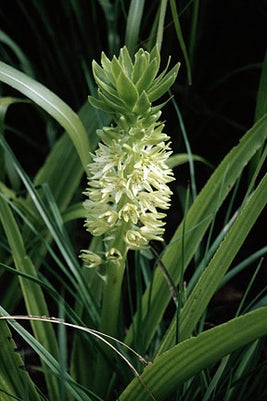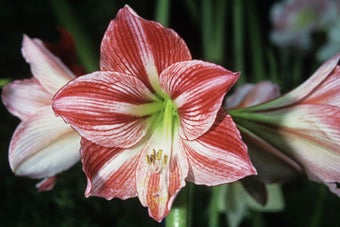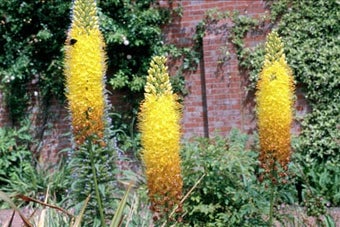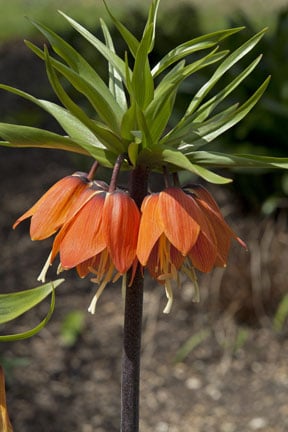
Quick facts
Common name - Pineapple flower and pineapple lily
Botanical name - Eucomis
Group - Bulb
Flowering time - Late summer to mid-autumn (August-October)
Planting time - Spring (April to early May)
Height and spread - Up to 75cm (30in) by 20cm (8in)
Aspect - Sun
Hardiness - Borderline hardy
Difficulty - Easy
Cultivation notes
Frost-hardy pineapple flowers can be grown outdoors in the southern parts of the UK, but in other areas, grow them in containers and move to a sheltered position when the weather cools.
Planting in the garden
Plant 15cm (6in) deep to help prevent frost damage, in fertile, well-drained soil, in full sun. Avoid shady areas of the garden, but also make sure that the pineapple flower won’t be shaded by other plants as they grow. Excessive shade will reduce the flowering.
Keep plants well watered during the growing season (April to early October). Don’t let them dry out, as you won’t get such a good flowering display.
Each spring, top-dress with a general fertiliser, such as Growmore or fish, blood and bone at 50-70g per square metre (1½-2oz per square yard).
Growing in containers
Plant in a wide, shallow pan, if possible. A normal-shape flower pot will do, but is less stable when the bulbs are fully grown. Use a loam-based , such as John Innes No.3, with added or horticultural grit to improve the drainage.
Allow at least 7.5cm (3in) between bulbs, but up to 15cm (6in) will still produce a striking display. Make sure that the top of the bulb is just below soil’s surface.
Just like plants in the garden, keep well watered during the growing season (April to early October) and apply a balanced, liquid-feed fortnightly.
Winter protection
In winter, protect the bulbs in the garden with a layer, about 10cm (4in) thick, of dry , such as or leafmould. Alternatively, lift the bulbs, dry them off and store in a frost-free place, such as a greenhouse or shed.
Containers can be brought into a frost-free place in October. You can allow the compost to dry out and the bulbs will become . Remove all the dry and yellowed foliage. Begin watering again in late March or April.
Pruning and training
Pineapple flowers don’t require any pruning. Just remove dead leaves, which usually appear in autumn or if the are dried off for the winter, and cut away the old flower heads once they become untidy.
Propagation
It is possible to reproduce pineapple flowers by seed and by dividing the bulbs. There is also the more unusual and involved method of taking leaf cuttings.
Leaf cuttings
- Take leaf in early to mid-summer
- Choose a healthy, undamaged newly-matured leaf from a well-watered plant
- Use a sharp knife to cut through the base of the leaf, making sure not to damage the remaining leaves
- To raise a larger number of plants, cut the leaf across the midrib into 4-6cm (1½in–2½in) sections, ensuring you keep them facing the direction they grew on the plant. Alternatively, make the cuts into shallow chevrons to point the way for you
- Insert the cuttings vertically 2.5cm (1in) deep into pots or trays filled with moist cuttings
- Place in a , or cover with a clear plastic bag, and keep at 20°C (68°F). Do not overwater and remove the cover twice a week for a few hours to prevent rotting
- After eight to ten weeks, individually pot up the bulblets that have formed along the bottom edge of the leaf sections
Caring for young bulblets
- Plant the young bulblets into individual pots and keep in a sunny spot
- Water well when in active growth. Reduce watering during the winter months and keep the young plants in a protected environment, such as frost-free greenhouse, for the first two winters
- The bulblets are fast-growing and will require regular repotting
- They will flower in two to five years
Cultivar Selection
Choose from an attractive list of eucomis available to gardeners;
- Eucomis autumnalis – pale greenish flowers
- E. bicolor AGM – pale green, purple margined blooms
- E. comosa – white flowers with purple tepals (fused petals)
- E. comosa 'Sparkling Burgundy' – reddish-purple foliage and purple-tinted flowers
- E. pallidiflora AGM – greenish white flowers
Links
Problems
Outdoor-grown plants can be damaged by the low winter temperatures. In colder areas, consider growing in containers in a greenhouse or conservatory.
Flower development may be poor on light, sandy soils or sites prone to drying out. Avoid shade and ensure they are not smothered by the foliage of other plants. Keep the plant well watered. Watch out for slugs, snails and aphids.





